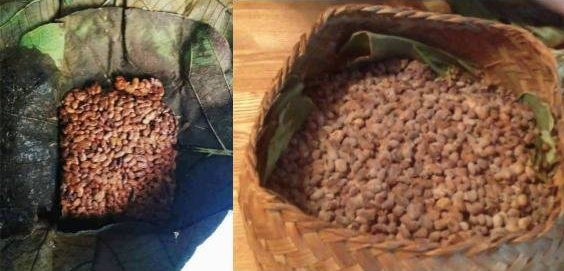Hawaijar - a fermented soybean food of Manipur, a culturally and gastronomically important indigenously produced food. It is alkaline, sticky, mucilaginous and slightly pungent and bears similar properties with many fermented soybean foods of Sountheast Asia like natto of Japan, douchi of China, thua nao of Thailand, choongkook jang of Korea.
The Art of Fermentation: The Journey of Hawaijar
At the core of Hawaijar's charm lies the intricate process of fermentation. The journey begins with soybeans, an abundant and protein-rich legume. These soybeans are soaked in water, allowing them to swell and soften. With a pot the soyabean is slightly boiled. Then, they are drained and cool it down for few minutes. Then the boiled beans are spread thinly on a wide leaf of a tree called Asi Heibong (Ficus hispida), a special one for this method (commonly called Hawaijar Mana), and placed in a ventilated container layer by layer, typically woven bamboo baskets, allowing air to circulate. This is where the magic happens. These Manipuri people usually kept this basket inside a Fou Kei or Kot (a store room or big container where people kept all the cultivated crops for seasoning).
The soybeans are left to ferment naturally, often encouraged by wild microorganisms present in the environment. Over the course of several days or even weeks, the soybeans undergo a transformative process. As they ferment, they acquire a nutty, umami-rich flavor and a unique aroma that's distinctly Hawaijar.
The art of fermentation is a testament to Manipuri culinary traditions and the resourcefulness of its people. It not only enhances the flavors but also contributes to the preservation of soybeans, ensuring their availability for an extended period.
The Scientific Abstract
The functional microorganism is Bacillus and has numerous health benefits like fibrinolytic enzyme, antioxidant, antidiabetic, and ACE inhibitory activities. It is also very rich in nutrients but unscrupulous production method and sale lead to food safety issues. Huge potential pathogen population upto the level of 107-10 cfu/g Bacillus cereus and Proteus mirabilis were detected. Recent studies revealed presence of enterotoxic and urease gene in microorganisms originated from hawaijar. Improved and regulated food chain will result in hygienic and safe hawaijar. It has scope for functional food and nutraceutical global market and hold potential to provide employment to enhance the overall socioeconomic status of the region. Scientific production of fermented soybean over the traditional methods is summarized in this paper along with food safety and health benefits. Microbiological aspects on fermented soybean along with nutritive values are critically explained inside the paper.
The Value of Hawaijar: A Culinary Gem
Hawaijar is more than just a condiment; it's a cultural emblem and a key ingredient in Manipuri cuisine. It plays a pivotal role in many traditional dishes, imparting a profound and complex flavor profile that elevates the overall culinary experience.
One of its most celebrated uses is in the creation of flavorful curry. Here, Hawaijar is combined with a blend of spices and herbs, resulting in a creamy and aromatic dish that's a testament to Manipuri culinary creativity.
But Hawaijar's significance extends beyond its culinary value. It's a symbol of Manipur's resourceful and sustainable approach to food. As a fermented ingredient, Hawaijar is not only a flavor enhancer but also a source of essential nutrients and probiotics, promoting gut health and overall well-being.
So, when you embark on a culinary adventure in Manipur, make sure to savor the magic of Hawaijar. It's a testament to the art of fermentation and the rich cultural heritage of Manipur, encapsulating centuries of tradition and flavors in a single, unassuming soybean.









1 Comment